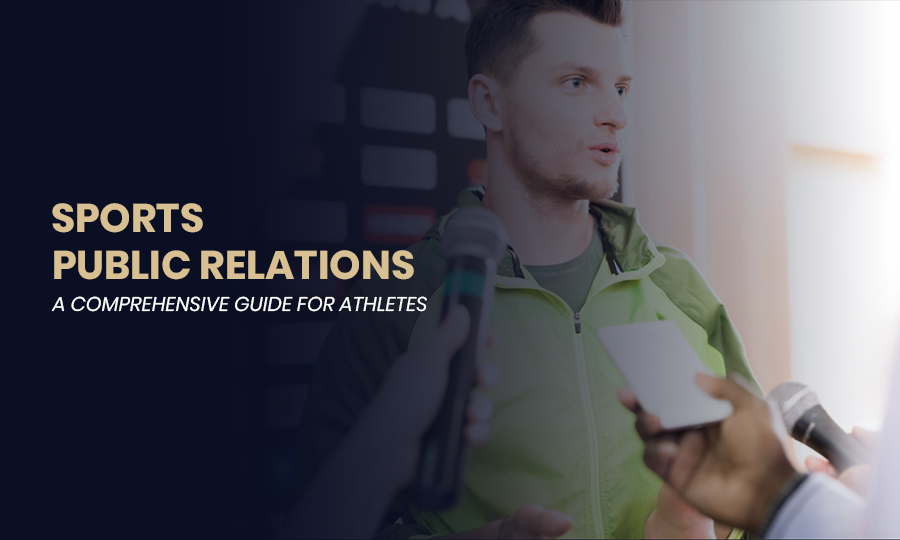Are you among those who believe that PR has become an outdated marketing strategy for athletes with the increasing popularity of social media and other online communication channels?
If yes, let us reveal that the reality is far from your belief! Despite the impact of social media, sports public relations, or sports PR, is considered one of the most effective marketing techniques for athletes. In today’s highly competitive sports industry, traditional PR methods play a crucial role in establishing and maintaining an athlete’s positive public image.
Did you know that the sports industry was expected to rise into a $500 billion global powerhouse in 2023? And all these were driven by increasing fan engagement and expanding the multi-billion-dollar market across apparel, entertainment, betting, and esports.
Without effective PR strategies, these would not have been possible!
Here in this blog, we’ll discuss how sports PR can enhance the online reputation and public relations of athletes. Furthermore, you’ll learn how an athlete can use effective public relations strategies to ensure their professional success and sustainability.
What is Sports Public Relations?
It refers to the strategic communication process of promoting and monitoring the public image of athletes, sports teams, and sports organizations through various media channels. Sports personalities like athletes often employ this strategy to establish and maintain mutually beneficial relationships with their target audience.
As an athlete, you can leverage the following media channels to build a positive public image and achieve your career goals.
- Press releases
- Press conferences
- Interviews
- Social media
Sports PR is all about public relations for sports teams and individual athletes, who need to establish media relationships with sports journalists, PR professionals, and PR agencies to get their targeted publicity.
How Do Sports PR Professionals Work?
Now, this is a crucial question! PR allows the media to spread crucial information about athletes, intending to create and maintain their positive public image. From building media relations and planning events to managing crises, it involves a range of activities.
PR agencies or professionals help athletes positively transform the way the public and stakeholders perceive them. Here is the process –
- When an athlete hires a PR professional, he/she contacts sports journalists and reporters to ensure accurate and positive media coverage.
- The PR experts closely communicate with the athletes to understand their goals and requirements.
- Based on their unique requirements, PR professionals will develop personalized strategies for athletes to deliver their stories and messages to their target audience.
- They plan to deliver sports stories of athletes that resonate with their audience and create a strong emotional connection with the help of media coverage.
- PR professionals, athletes provide the media with engaging stories and insights (through press releases, conferences, and interviews) about athletes and other sports persons.
- This builds a positive image of the athletes that they can use to attract sponsors, investors, and even fans.
For example, an athlete has become a role model in the eyes of his/her fans over the years by delivering extraordinary performances in sports. Unfortunately, he/she starts struggling to maintain this positive image for long. The athlete should seek help from a PR agency to convey their stories under the professional guidance of an expert PR team.
Why Sports PR Matters?
PR in sports is a multifaceted domain that goes beyond just simple media interactions. Apart from an outstanding performance, winning championship titles, and extraordinary celebrations, every athlete must know the secret of storytelling and building a loyal fanbase – it’s sports public relations.
Sports PR is not just about creating hype about an athlete; it’s about building an athlete’s legacy, voice, visibility, and a favorable image.
Let’s have a look at why sports PR matters for athletes’ reputations.
- Builds a Strong Public Image
Sports PR helps athletes build a positive brand image and shape public perception about them. It positively transforms how the audience perceives a specific sports personality. With effective PR, athletes can expertly deal with negative publicity and protect their brand image even before the public knows about it.
Want to create long-lasting positive associations and narratives around your public image as an athlete? Sports PR will help you in this as well!
- Helps in Crisis Management
When in a crisis, such as a scandal or negative breaking news, athletes must prioritize seeking professional PR guidance. Sports PR techniques can help them seamlessly handle these critical issues without affecting their reputation.
Imagine a cricketer’s name gets involved in an incident of match fixing. It is more likely that the cricketer will face massive public criticism and negative publicity. If he/she considers sports PR in such a situation, it will reduce the severity of the negative impact on his/her reputation.
- Enhances Media Relations
As we’ve already mentioned, PR professionals and agencies work closely with the media to ensure positive media coverage of their clients. PR professionals convey news about athletes to the media using press releases and media outreach.
For example, you want to share specific news of your recent achievement as an athlete through media outreach and engage with your fans more effectively. You can seek PR guidance from experts, so that they can help you communicate your news in the best way possible with the help of influential journalists. This way, you can build connections with prominent sports media personalities.
- Boosts Brand Building
Personal branding is the heart of sports PR, as athletes, just like other celebrities, must cultivate a positive and unique public image. The success of online reputation management for celebrities like prominent sports personalities lies in the effectiveness of sports PR strategies.
PR agencies work closely with athletes to identify their unique requirements and values, and try to convey stories. They craft favorable narratives about the athletes to highlight their personal journeys, struggles, achievements, and beyond. All these are crucial to the personal brand building of athletes, making them connect with their fans on a deeper level and earn a loyal fan following.
- Increase Fan Engagement
With effective PR, athletes can build interpersonal relationships with their fans. They can develop PR campaigns and organize events to engage with their fans more effectively. By implementing social media strategies and fan events, athletes can participate in meaningful interactions with their fans.
Another crucial benefit? When an athlete engages with their fans and gets to know about content preferences, they can generate content that their fans will find more relatable.
- Drives More Sponsorships and Endorsements
In today’s competitive scenario, it’s essential for athletes to secure valuable sponsorships and endorsements to stand out in the sports industry. PR helps athletes develop beneficial relationships with renowned companies and negotiate contracts.
As effective sports public relations is closely associated with improving the public image and reputation of athletes, it helps them attract more sponsorships and endorsement opportunities.
8 Best Strategies for Sports Public Relations to Help Athletes
Till now, we’ve talked about how sports PR can benefit an athlete. But you can only leverage the benefits with the right strategies!
Sports PR is all about maintaining a positive public image of an athlete by conveying their stories and messages to their audience in the most effective way. And this requires you to implement effective sports PR strategies.
Below, we have discussed the top 8 most impactful sports PR strategies that athletes can use to stay Relevant, Remembered, and Respected.
Strategy 1: Craft a Compelling Brand Identity
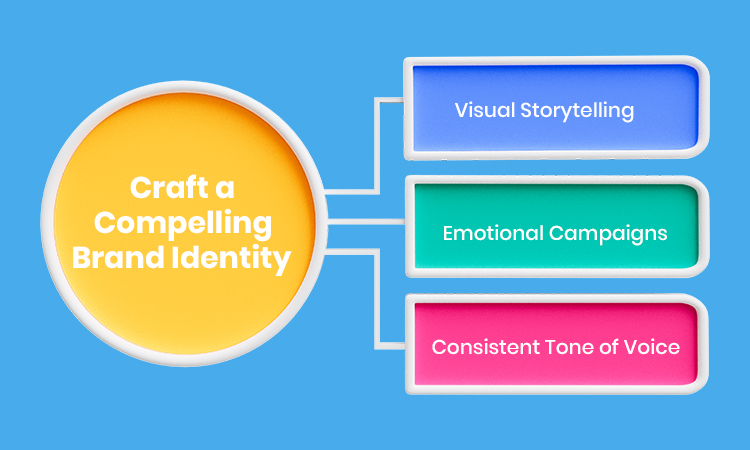
An athlete is more than just his/her sports journey and achievements. It’s about their brand name and identity – the way people, including their fans and followers, perceive them.
When you want to publicize yourself as an athlete, the first step is to create a compelling brand identity!
Why is it important? A brand identity helps athletes define and promote their brand story most effectively. It also ensures that their story resonates well with their target audience and builds emotional connections between them.
This is not only about creating a logo, tagline, or color schemes! Crafting a brand identity for a sports person goes beyond all these. Try to prioritize the answers to these questions:
- What values do you represent as an athlete?
- What kind of legacy do you want to create as an athlete?
- How do you want your athletic personality to be perceived by your fans, media people, and sponsors?
The answers to these questions will help you craft your brand identity.
If you hire PR professionals, they will work closely with online marketing and creative teams to ensure they convey your brand messaging across all touchpoints.
How do Sports PR Professionals Create Brand Identity for Athletes?
Sports PR professionals often create a brand identity for their clients through the following strategies –
- Visual Storytelling
Sport PR teams often work with creative experts to develop a consistent visual language, such as logos, color palettes, typography, and attractive imagery. They ensure that these elements reflect the specific athlete’s unique personality and brand values.
They highlight the genuine personality, experiences, and off-field activities of their athlete clients, apart from promoting just their on-field performances. PR experts share these visual elements across various online platforms (social media, websites, and emails) to ensure a wider reach and reinforce the brand identity of the athletes.
- Emotional Campaigns
It’s crucial to identify compelling narratives about the athlete’s journey! Stories about their personal struggles, journey to become a successful sports person, comebacks after failures, and remarkable milestones in their career can create emotional connections with fans.
PR professionals often create tailored campaigns to evoke specific emotions (inspiration, hope, and nostalgia) in their audience, fostering a deeper connection.
- Consistent Tone of Voice
Does your sports brand have a voice? If not, let us tell you that it’s essential. You can consider sports PR to develop a brand voice that highlights the specific style, language, and vocabulary you use as an athlete for all your communications.
PR experts always try to maintain consistency in their clients’ brand voice across all platforms. But before that, they work closely with the athletes to understand the way they interact on social media, during interviews, and at public appearances.
Strategy 2: Prioritize Proactive Media Engagement and Storytelling
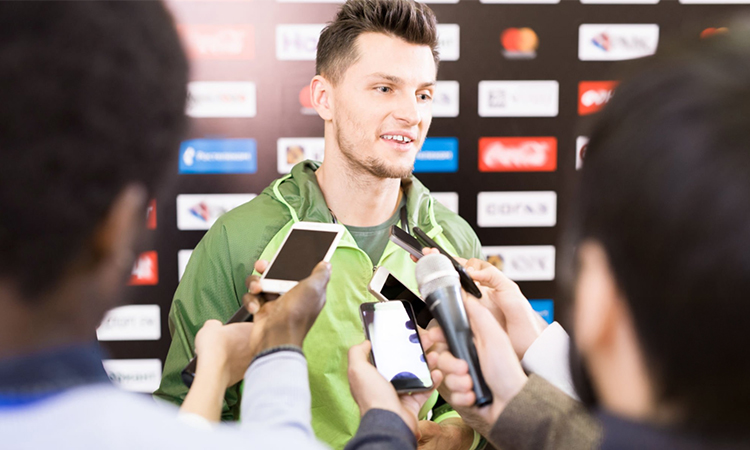
Athletes don’t wait for the media to come knocking after they achieve a triumph or experience a failure; they lead the narrative. As an athlete, you must consider proactive engagement with prominent media personalities and build lasting relationships with them.
Athletes must prioritize establishing good connections with –
- Journalists
- Editors
- Reporters
- Influencers
- Content creators
Specifically, with those whom people follow and are influenced by, but all it requires is how the athletes pitch their stories to the media professionals with the help of PR experts. A sports PR job is crucial here as he/she needs to identify which story resonates with their target audience the most.
The stories can be –
- Pre and post-game briefings
- Exclusive behind-the-scenes features
- Player spotlight briefings (for example, an athlete who is overcoming adversity)
- Timely press releases and announcements of achievements
It’s all about how a PR professional pitches your story so that the media person feels interested and eager to share the same with your audience.
And what are the benefits of hiring PR professionals to ensure successful storytelling and media engagement?
- A sports public relations professional knows how to pitch an athlete’s story to the media that matches the news cycle.
- They know how to ensure the athlete’s story and brand messaging reach the right media outlets.
- PR experts ensure that the athlete’s fans and sponsors perceive more than just their scores, performances, and achievements – their personality, character, heart, and ambition.
- Additionally, they know how to pitch the media to ensure it effectively conveys the athlete’s story to turn fleeting moments into enduring legends.
Strategy 3: Leverage Social Media
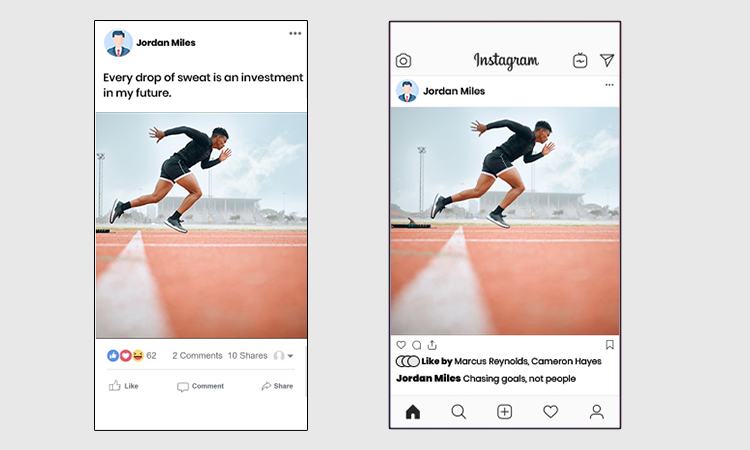
Social media has been one of the greatest platforms for sports personalities, especially to engage with their fans and followers. With the rise of social media usage, the majority of athletes prefer to use social media when they want to share any relevant news with their fans.
Did you know that 58% of 16-24-year-olds and 49% of 25-34-year-olds are more likely to follow athletes on social media?
In today’s digital age, social media platforms offer an unparalleled opportunity for athletes to seamlessly connect with their fans and initiate direct communication. And that’s what sports PR specialists use.
They leverage these social media platforms like Facebook, Twitter (now known as X), Instagram, LinkedIn, and YouTube. They share important updates about their athlete clients and create engaging content to post on social media.
Social media PR for athletes is not just about the digital presence; it’s about the digital connections.
Why does social media act as a PR tool for athletes? Nowadays, social media is where sports fandoms thrive. Fans of various sports teams and personalities create social media groups to interact with each other and share updates about their favorite teams and athletes.
However, one thing you must remember is that PR through social media is not only about regularly posting diverse content. It requires strategies storytelling that involves –
- Create a content calendar – You need to create a content calendar to plan what content you should post in a week. This will ensure that you never miss an opportunity to engage with more social media followers.
- Highlight your achievements – You must announce your wins, records, and milestones with your followers on social media. Share photos and videos of your victories by mentioning your personal best performances as an athlete. You can also celebrate your team’s accomplishments on social media.
- Offer live updates – Your fans love to get real-time updates of your sporting events! PR professionals often post live updates during matches and training moments to boost the social media visibility of their athletic clients.
- Use user-generated content – You can encourage your fans and followers to share their feedback and opinions about your sports performances and achievements. Your followers can also share fan moments with you on social media by tagging your profile.
If you post user-generated content on your social media, it will add a touch of personalization to your social media profile. Furthermore, it will also showcase how well you engage with your followers and value their opinions.
- Showcase your personality and brand – Offer a glimpse of your behind-the-scenes content about your training, travel, and personal life. For example, an athlete has overcome adversity or has some unique skills.
You can share social media content about your unique skills and personal growth to make it more personalized. Post interactive social media posts, Q&As, and polls to connect with your fans more closely.
- Share reels and visual content – You can create reels to show training montages and interviews. Content is King! So written content like blog posts and articles can also perform well on social media if it is informative and interactive.
- Tailor your content – Every social media platform has its unique audience, and their content preferences are unique as well. You can create diverse content and personalize it based on the unique features of each platform, such as Instagram stories, TikTok videos, and YouTube shorts.
- Partner with influencers – Athletes must collaborate with popular social media influencers to promote their content. They can also partner with other renowned sports personalities and organizations to reach a wider audience.
Strategy 4: Empower Athletes as Spokespersons and Influencers
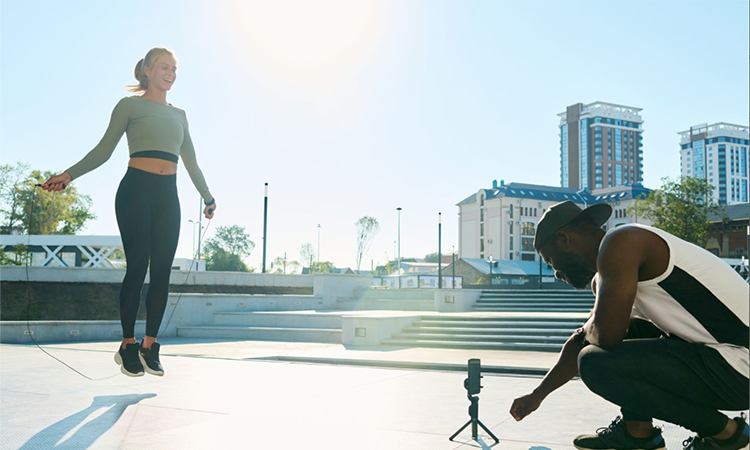
As we’ve talked about how an athlete can use social media to boost his/her public relations, let us tell you that social media offers a platform where athletes can play the role of a spokesperson and influencer for their followers.
A 2025 Gitnux study has claimed that 85% of sports organizations tend to see increased fan engagement through social media promotional campaigns. In today’s digital age, athletes are more than just performers; they’re brands, social media influencers, and even cultural icons.
Sports PR experts empower athletes to become spokespersons and influencers and build their public image authentically. Sports personalities can play the role of social media influencers through –
- Promotions of their brand or other businesses
- Social media guidance and content support
- Sharing their personal journeys, passions, and challenges
- Promotions of their off-field interest in fashion, entertainment, lifestyle, and health
Example: An athlete who has a profound knowledge of fashion and clothes can share content related to this on social media platforms. If an athlete has a food brand entrepreneur, he/she can promote it by showing various products of the brand on social media.
Objective: This PR strategy aims to provide professional sports personalities with helpful tools to confidently speak for themselves in front of their target audience. It’s all about making the athletes ambassadors of their sports brand – a magnet for sponsors, fans, and stakeholders.
Always remember – Fans follow sports teams, but they feel emotionally connected with players!
Strategy 5: Plan Crisis Communication and Management
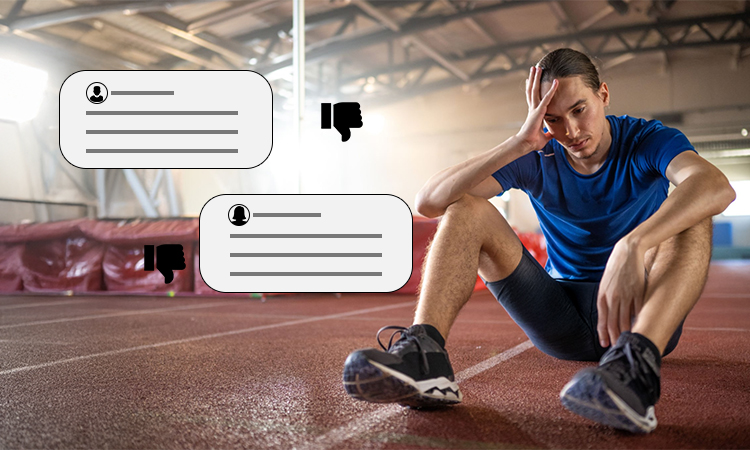
Sports public relations plays a crucial role in crisis communication and management. It determines whether an athlete or a sports team will bounce back after facing a major downfall or not.
Yes, you heard that right! The sports industry is closely associated with communication relations. Even the slightest issue that occurs in the community can lead to –
- Scandals
- Trade rumors
- Controversies
- Negative news circulation
- Off-field unfavorable incidents
- Fake media reports
How an athlete or sports team responds in a crisis shows how strong they are. This is where sports PR firms prove their significance!
PR specialists work tirelessly to develop tailored crisis management plans for athletes, which often include-
- They brainstorm scenarios to identify potential crises beforehand. PR professionals identify crises like injury incidents, social media controversies, player misconduct, and financial irregularities to create a robust crisis management plan well in advance.
- PR specialists often build a team with communication, legal, and leadership experts. They define the roles and responsibilities of those experts.
- They determine how information about their clients will be shared internally and externally, such as media contract procedures.
- Early warning signs of potential crises are also monitored by PR agencies based on the data they collect through social media and other relevant media channels.
- When in crisis, it’s crucial to act fast and decisively. PR experts need to promptly respond to a crisis faced by their athlete clients and acknowledge the situation.
- They communicate openly and truthfully with an athlete’s key stakeholders and media connections. Maintaining transparency and honesty work best during a crisis.
- If the athlete is at fault, it’s important to issue a sincere public apology and make informed decisions to address the issue.
A crisis occurs to make you learn from your past mistakes! It offers an athlete an opportunity to win their followers’ and fans’ trust back and rebuild their brand reputation.
Note: If you’re an athlete, we recommend that you conduct a thorough review of the crisis management process to identify areas for improvement. It’ll help you prevent the risk of similar crises in the future.
If an athlete experiences a crisis, he/she must consider the following factors for sports PR.
- They must have excellent interpersonal skills to approach the PR professionals and media to convey the right messaging about the ongoing crisis to their followers.
- Athletes must ensure all their actions and communication align with the legal regulations and requirements.
- Additionally, they consider the potential impact of their crisis on their sponsors. It will help them plan strategies to manage their relationships with their sponsors.
Do you know that you can lose your fans, sponsors, and even credibility overnight due to a crisis? The solution is to maintain your empathetic behavior and transparency while communicating with this significant group of people.
Strategy 6: Consider CSR Management and Community Engagement
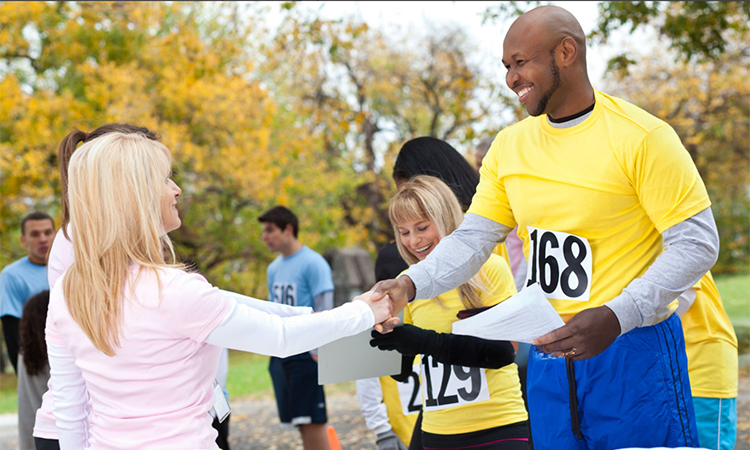
Sports PR is not about the buzz; it’s about building interpersonal connections with the community through visible impact. And CSR can help athletes establish such profitable community relations.
Wondering what CSR is? Let’s understand it in detail.
What is CSR? It stands for corporate social responsibility that humanizes brands and creates emotional investments among fans. Community engagement programs serve the same purpose! Only executing these CSR strategies is not enough! These efforts must be communicated effectively as well.
Some examples of CSR and community engagement programs for sports are –
- Youth sports training camps and mentorship events
- Active participation in local health and wellness initiatives
- Meaningful partnership with charity and nonprofit organizations
- Mental health campaigns, local events on diversity and environmental sustainability
- Providing aid during disasters or social crises
Strategy 7: Establish Strategic Partnerships and Sponsorship PR

And now we’ll talk about one of the most effective PR strategies for athletes, which is sponsorship.
Do you know that sponsorship has become the largest segment in sports marketing accounting for more than 50% of the total sports marketing revenue? This statistic shows how important sponsorships are for athletes.
Today, sports sponsorships are not only about promoting the sponsors on the logos of sports teams or on the jerseys of players.
Sponsorships are strategic alignments that convey shared values and purpose. A successful sports public relations strategy ensures an athlete’s partnerships remain meaningful and mutually beneficial.
Top Helpful Tactics for Sponsorship PR and Partnerships
Key sponsorship PR strategies involve –
- Identify right brands – Athletes must identify brands that best suit their individual or team’s values and ethos.
- Co-organize campaigns – They need to co-create campaigns that can effortlessly blend team culture with their sponsor messaging.
- Plan public announcements – Some crucial responsibilities ahead! Athletes need to manage press announcements, influencer collaborations, and event planning with the help of PR agencies.
- Produce branded content – They must develop branded content that resonates with their followers and the PR team.
- Promote sponsorships success – Want to showcase how you achieve sponsorship success? You can promote these partnership achievements with fan engagement data and case studies through various online media channels.
When executed well, sports sponsorships can become stories of athletes’ success, not just transactions. With the right PR strategies, it can extend an athlete’s reach, boost his/her credibility, and drive revenue.
Strategy 8: Measuring PR Success
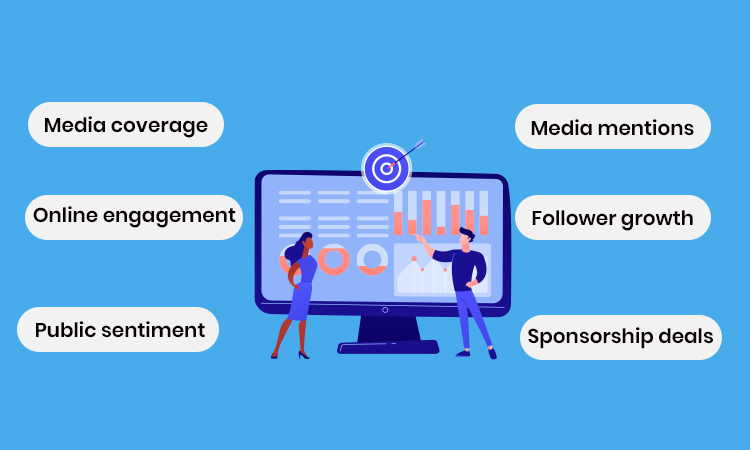
Public relations strategies for celebrities like athletes are effective only when you measure PR success. It’s also helpful to refine and improve your future PR efforts. Athletes need to track the same key performance metrics, such as –
- Media coverage – The number of media mentions, such as in press releases, articles, and interviews, to assess the impact
- Online engagement – Social media engagement, such as likes, shares, and comments, to gauge audience interaction and sentiment
- Public sentiment – Public opinion about the sports team or event to identify areas of positive and negative perception
- Media mentions – Online mentions of your name across the web, including social media platforms
- Follower growth – The increasing number of followers on social media platforms to understand the improvement in brand awareness
- Sponsorship deals – Impact of sponsorship deals, customer inquiries, conversions, and overall brand awareness
When you track these metrics, it will help you gauge the effectiveness your PR initiatives. As an athlete, you can also identify the areas of improvement and make necessary adjustments in your public relations strategies for maximum impact.
Some tools to track your PR performance –
- Mention – It’s a popular tool for tracking brand mentions; you can use this tool to track your name mentions in social media, news sites, and blogs.
- Hootsuite – A popular platform for social media management and analytics, it’s best for tracking engagement, reach, and your social media follower growth.
- Meltwater – A comprehensive tool for media monitoring and social listening, it offers insights about brand mentions, media coverage, and audience engagement.
- Google Analytics – Have a website for your sports brand? This tool can help you track website traffic and conversions from your sports PR efforts
Essential Tools for Sports PR You Must Know
Now that you’ve a clear idea of the sports PR strategies that you can implement to improve your public image as an athlete, it’s time to make your process a little easier!
Yes, we understand that PR is complex. But the right tools can simplify even this complex process. Here, we’ll talk about some helpful tools for every PR activity an athlete can perform to enhance their public image.
Interesting, right? Let’s get started!
- Meltwater – You can use this tool to monitor your media coverage and track mentions by online media channels. Additionally, you can analyze public sentiment about you as a sports personality.
- Google Alerts – With this tool, athletes can receive email notifications whenever their name is mentioned online. They can also receive alerts for specific keywords related to their sports niche.
- Hootsuite – Want to schedule your PR posts on social media? Hootsuite can help you effortlessly schedule and manage your sports PR posts across various social media platforms. With this tool, you’ll never miss the chance to drive more traffic and engagement to your PR posts!
- Sprout Social – PR professionals often prefer to use this specific tool for social listening and drive more follower engagement for their athlete clients. Sprout Social can be used as an analytical tool as well.
- PRNEWS.IO – This platform can help athletes distribute press releases to a wide network of media outlets. It allows athletes to publish sponsored content, targeting specific audiences.
- Business Wire – This tool offers you a global platform where you can seamlessly distribute news related to your journey, achievements, and memorable events as an athlete.
- Mailchimp – Email marketing for sports PR – the best idea indeed! You can use Mailchimp to send newsletters through email, share updates, and make important announcements to engage more with your followers.
- Constant Contact – This tool is also an outstanding solution for sports PR professionals who want to leverage email marketing for their clients. Additional feature? Constant Contact offers you customizable templates that you can use for sending PR emails.
- Google Analytics – Many renowned sports personalities often have their own website. PR professionals can use Google Analytics to track website traffic, user behavior, and engagement.
- Crisp – It’s quite common for athletes to experience PR crises. Crisp is one of those helpful tools that help monitor social media to identify potential crises and provide real-time alerts beforehand. Athletes can identify social media trolls and controversies and develop crisis management plans to protect their reputation.
- Critical Mention – Traditional promotional channels like television and radio are a crucial part of sports public relations for athletes. PR professionals can use this specific tool to monitor TV and radio broadcasts, get insights, and track media coverage.
- SurveyMonkey – Fan engagement is a non-negotiable element to ensure the success of a sports PR plan. SurveyMonkey allows athletes to gather feedback from fans, sponsors, and stakeholders through engaging surveys.
Common Sports PR Challenges an Athlete Can Face
Athletes, being prominent personalities in the sports industry, often face several challenges. From managing a positive brand image to handling reputation crises, sports PR challenges are quite difficult to deal with. This requires athletes to carefully maintain and protect a positive reputation.
But without identifying these challenges beforehand, an athlete cannot handle PR crises skillfully. Let’s have a look at the common sports PR challenges you can face as an athlete.
- Managing a Positive Brand Image – Athletes constantly need to build and maintain a positive brand image, being the influential personalities for their fans. Sometimes, it becomes a challenge for them as athletes are also likely to face social media trolls, controversies like match fixing, and negative news circulation.
- Navigating Media Relations – Athletes must establish good relations with PR professionals and journalists. Maintaining good media relations is crucial for athletes if they want to prioritize sports PR to maintain their public image. They need to manage interviews, press conferences, and media appearances for which good media relations are crucial. It’s important for securing positive media coverage as well.
- Handling Crisis – A crisis can occur at any time when an athlete is at the peak of his/her career or even when he/she is already facing some downfall. Thus, handling crises can be difficult at times; of course, it depends on the severity of the crisis. Athletes must be skilled in handling various types of reputational crises and maintain effective communication with their fans and followers, along with the media and stakeholders. Taking necessary actions at the right time during crises to prevent reputational damage is a challenge in itself!
- Dealing with Diverse PR Needs – Every athlete has some unique public relations-related needs based on their diverse backgrounds and situations. Cultural sensitivity plays a crucial role here! Crises can differ from athlete to athlete. Thus, athletes need to identify their PR objectives and understand which PR activities can help them the most.
- Addressing Ethical Considerations – Sports persons must prioritize their ethical considerations, like rules and regulations, to promote fair play and integrity. They need to combat doping and other forms of cheating. Identifying potential conflicts of interest can also be difficult for maintaining transparency and trust.
Sports PR Crisis Case Study
Here are some case studies of successful sports PR and PR blunders. These case studies will help you identify your requirements and manage your brand reputation better.
Successful PR Campaign of Sports England
One great example of a successful sports PR campaign is Sport England’s ‘This Girl Can’ initiative.
Objective: The brand launched this PR campaign in 2015, intending to promote women’s active participation in sports. Additionally, the company aimed to challenge traditional stereotypes related to breaking down barriers of gender inequality in sports.
PR Excellence: The brand performed effective PR activities like empowering advertisements and building a strong online presence. Their PR campaign earned widespread attention and was successful in encouraging numerous women to participate in sports.
PR Blunders in Lance Armstrong’s Doping Case
A prominent example of PR blunder is Cyclist Lance Armstrong’s doping scandal in 2013, when he thought his use of performance-enhancing drugs was a way to level up his performance in the playing field.
Scandal: In a television interview, he cyclist confessed to using banned performance-enhancing drugs and blood transfusions during his cycling career. After an in-depth investigation by the United States Anti-Doping Agency, the accusation against Armstrong related to his doping activities was verified.
Due to poor decision-making and inadequate crisis management skills, his brand reputation was at stake. As a result of this, he was banned from Olympic sports for life and stripped of his seven Tour de France titles.
PR Blunder: The incident severely damaged his reputation as well as tainted his public image in the professional cycling field. Isn’t this a reminder that the success of sports PR highly depends on the athlete’s transparency, ethical conduct, and proactive crisis management capabilities?
LeBron James’s Public Image Restoration through Effective Sports PR
LeBron James is an American professional basketball player who faced a massive public relations crisis in 2010 after he announced his departure from the Cleveland Cavaliers during his televised show ‘The Decision’. He also announced that he was joining the Miami Heat.
Crisis: The broadcast was watched by 13.1 million viewers, which triggered immediate backlash from the media and Cleveland’s fans. They even burned jerseys in the streets while the commentators heavily criticized the format as insensitive and self-indulgent to loyal Cavaliers supporters.
PR Excellence: James’s exceptional PR team developed a tailored public image restoration strategy based on Benoit’s Image Restoration Theory. They planned authentic community engagement through James’ Family Foundation.
The PR activities were aimed at building a strategic social media presence and carefully planned media appearances showing vulnerability and personal growth. He also donated a $41 million fund for Akron students’ college athletics scholarships.
In 2014, James had transformed his narrative when he returned to Cleveland and framed his decision as ‘coming home’. This strategic sports public relations tactic proved to be an outstanding idea later, as it resonated emotionally with the fans and media, rebuilding public image.
FAQs
Yes, it’s necessary. Sports teams and athletes are often considered as prominent personalities or celebrities, as millions of people follow them. In today’s digital scenario, athletes often play the role of influencers and encourage their fans and followers related to various crucial matters.
Thus, they must maintain a positive public image and effectively handle reputation crises. Sports PR can help athletes and other sports personalities engage more with their fans and maintain their positive reputation.
No, it’s not necessary if you have an in-house PR team to handle your public relations as an athlete. But if you have not and want to protect your public image, you can hire a reputable PR agency with a team of sports PR experts. Sports PR professionals are skilled in handling various reputation crises and maintaining the brand image of their athlete clients. You can get professional PR guidance and support if you hire a sports PR agency.
Sports PR and sports marketing are related but with different focuses. For example, sports PR primarily helps sports organizations, athletes, and other sports persons build and maintain a positive public image. On the other hand, sports marketing helps to promote a sport’s related product, service, and event to consumers.
Sports organizations can measure the effectiveness of their PR strategies by using quantitative and qualitative metrics. They can track media coverage, perform sentiment analysis, check website traffic and social media engagement to measure the success of their PR efforts. These metrics can help them gauge the impact of their sports PR campaigns and identify areas for improvement.
Poor crisis management in sports can result in various serious consequences, such as reputational damage, financial losses, and even decreased fan engagement. Even in serious situations, it can lead to legal actions taken against the athletes and operational disruptions in a sports organization. This crisis management through effective public relations techniques is crucial to mitigate these risks and protect the integrity of the athlete involved.
Conclusion
Publicizing a personality is more difficult than promoting an organization. Publicizing a sports brand to an athlete comes with great responsibility, so as building strong relationships with media personalities like journalists and reporters to ensure positive coverage.
An incredible sports personality doesn’t necessarily have a positive public image and a good relationship with his/her fans. That’s where sports PR comes in. Sports PR plays the role of a bridge between athletes and the media. PR professionals ensure the media conveys the best possible public image of their athlete clients.
Consistent efforts and effective strategies are required for the success of sports public relations. Our comprehensive PR guide will help you understand how you can strengthen your PR efforts to maintain and protect your public image as an athlete. Explore our strategies and identify which strategy works best to meet your PR requirements.
Not skilled enough to handle PR? Athletes can also hire an online reputation management agency to build and manage a positive brand reputation.

